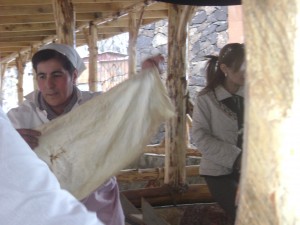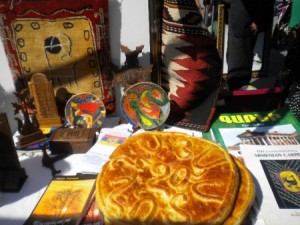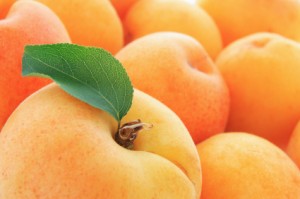All News
geghard
National meals
 LAVASH – Lavash is one of the important elements of the Armenian cuisine. The word lavash has Armenian origin and means “good food”. Lavash is a flat, soft and thin bread. It’s the most widespread type of bread in Armenia, and the basic bread in some regions. Lavash is baked in tonir (a big jar dug in the earth in which fire is made). The fire is made from the dry branches of grape, and the thin rolled out dough “is beaten” to the warm walls of the tonir with the help of a special pillow.Lavash can be dried and kept for a long time, and when it is watered it becomes fresh again. Lavash is the most compulsory and important element of all the festive tables. There are national meals in the Armenian cuisine which are eaten with lavash only.In Kotayk marz lavash is also used as basic bread. Lavash is made by a special receipt, that is flour, water and salt. The thickness of the bread varies and depends on how thin it is rolled out. The skills of making and baking lavash are being passed from generation to generation.
LAVASH – Lavash is one of the important elements of the Armenian cuisine. The word lavash has Armenian origin and means “good food”. Lavash is a flat, soft and thin bread. It’s the most widespread type of bread in Armenia, and the basic bread in some regions. Lavash is baked in tonir (a big jar dug in the earth in which fire is made). The fire is made from the dry branches of grape, and the thin rolled out dough “is beaten” to the warm walls of the tonir with the help of a special pillow.Lavash can be dried and kept for a long time, and when it is watered it becomes fresh again. Lavash is the most compulsory and important element of all the festive tables. There are national meals in the Armenian cuisine which are eaten with lavash only.In Kotayk marz lavash is also used as basic bread. Lavash is made by a special receipt, that is flour, water and salt. The thickness of the bread varies and depends on how thin it is rolled out. The skills of making and baking lavash are being passed from generation to generation.
GATA
On Trndez Armenian families bake round gata (a pastry of Eastern origin made of flour, butter and sugar) with a special
 ceremony. Armenian women are encouraged to put the love and warmth that they feel towards their family members into it, so that peace and success are present at their home the whole year. “Our ancestors used to bake gata in the tonir. The most interesting part is who gets the coin put in gata’s dough before baking”.Round gata is made of butter, flour, sugar, and egg. It is considered to be the most important decoration of of the Lord’s Presentation to the Temple (Trndez). Trndez (Tiarn’ndaraj), or Candlemas as it is known in the West, symbolizes the presentation of the 40 day-old Christ Child to the Temple in Jerusalem. Traditionally Armenian youngsters go round the fire, lit in the yard, for seven times, and then they start jumping over the fire for three times to “defeat evil.”“Earlier people used to put gata on a tray on the back of the youngest in the family, and only then they started cutting gata. Later they started eating it, and waiting impatiently to find out who got the coin”.TOLMAArmenian cuisine is one of the oldest ones in Asia and Transcaucasia. It arose thousand years ago B.C. and remained almost unchangeable during more than three millennia. How many years it exists, no one may know. Tolma is as old as Armenian cuisine. For making tolma we need grape leaves, fresh or preserved for winter. The pulp is made from beaten mutton, rice, spices and greens. The pulp rolled in the leaves. In general tolma is rolled very tightly, in order not to open during cooking. Tolma is served with some yogurt and garlic.
ceremony. Armenian women are encouraged to put the love and warmth that they feel towards their family members into it, so that peace and success are present at their home the whole year. “Our ancestors used to bake gata in the tonir. The most interesting part is who gets the coin put in gata’s dough before baking”.Round gata is made of butter, flour, sugar, and egg. It is considered to be the most important decoration of of the Lord’s Presentation to the Temple (Trndez). Trndez (Tiarn’ndaraj), or Candlemas as it is known in the West, symbolizes the presentation of the 40 day-old Christ Child to the Temple in Jerusalem. Traditionally Armenian youngsters go round the fire, lit in the yard, for seven times, and then they start jumping over the fire for three times to “defeat evil.”“Earlier people used to put gata on a tray on the back of the youngest in the family, and only then they started cutting gata. Later they started eating it, and waiting impatiently to find out who got the coin”.TOLMAArmenian cuisine is one of the oldest ones in Asia and Transcaucasia. It arose thousand years ago B.C. and remained almost unchangeable during more than three millennia. How many years it exists, no one may know. Tolma is as old as Armenian cuisine. For making tolma we need grape leaves, fresh or preserved for winter. The pulp is made from beaten mutton, rice, spices and greens. The pulp rolled in the leaves. In general tolma is rolled very tightly, in order not to open during cooking. Tolma is served with some yogurt and garlic.
SUJUKH
Sweet sujukh is the traditional component of the national cuisine of Kotayq Marz. Abundance of walnut trees and aged-old viticulture here are the bases of making sujukh. For preparing sujukh, shpot (substance like a thick jam) is made by adding some flour and species into grape juice.
The juice is cooked thick. Then, a chain of walnut is sunk into the mass repeatedly, for several times, after hanging to dry, in order to coat the chain with the mass.Sujukh making becomes a festival, guests are invited , who try shpot pouring in the plates and adding some walnuts on it.
APRICOTArmenia’s holy land has granted humanity one of the best and healthy fruits in the world, the apricot. Armenia is the motherland of the apricot, is the oldest and genuine center for growing apricot. This is proved by 3000 year old apricot cores discovered during excavations at Garni temple, 25 km far from Yerevan, the capital of Armenia. It is also testified by wide varieties of apricot trees growing in Armenia.
the motherland of the apricot, is the oldest and genuine center for growing apricot. This is proved by 3000 year old apricot cores discovered during excavations at Garni temple, 25 km far from Yerevan, the capital of Armenia. It is also testified by wide varieties of apricot trees growing in Armenia.

